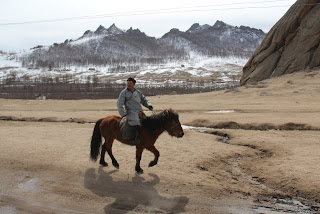Mongolia presents a striking contrast between the current movement towards urban life in Ulaanbaatar and its traditional nomadic roots.
The landscape is harsh, and not much grows - the large proportion of the Mongolian landscape that we saw (with the exception of our time at the ger camp) had almost no trees and very little vegetation. It gets incredibly cold in winter (a week before we got to Mongolia, Ulaanbaatar (UB) was recording as little as -24 degrees centigrade overnight, and highs that didn’t breach freezing point (note that our time in Mongolia was much more comfortable than that, with quite pleasant temperatures in the 5-10 degree range)), and very hot in summer (+30 degrees or hotter). Traditionally, farmers had to continually move their herds, as frequently as once a month (which involved taking down all of the gers and moving via cart to another temporary location). During very cold winters, many animals would die leaving the families they supported in desperation. Our guide told us that the cold winter in 2009/2010 forced a number of people to the city.
Mongolia has also recently embraced Democracy (1991). This appears to have been accompanied by a movement towards land ownership and the fencing of land. This in turn may be restricting the ability of the nomads to move. We understand that the nomadic families now only relocate about 4 times a year.
We also understand that the population is now roughly split 50/50 between urban and rural (or nomadic) dwellers, with almost all urban dwellers located in UB. UB’s rapid growth is not without its apparent problems. The traffic, its drivers and the roads could only be described as absolute chaos. Gridlock can be experienced almost any time of day, the horn is frequently used carrying a number of different meanings, and drivers adopt a casual disregard for any traffic laws, favouring a free-for-all approach. UB also has its fair share of crime. Our guide mentioned that someone tried to pinch his phone on the bus as he was coming to see us on our second day there.
 |
| The building on shaky foundations that has to be pulled down - pity |
The city also lacks a definitive centre. Although technically the square next to the parliament buildings with the statue of Chinngis (Genghis) Khan would probably be best described as the city centre, it lacked the vibrancy or feel of the ‘heart of the city’. An eye-catching and modern commercial building shaped like a sail, right next to the town square, could have been the first step in creating a dynamic city centre. But, after nearly being finished it was discovered the building has faulty foundations and is slipping over. For the last 3 or 4 years it has sat there, empty - the government want it pulled down. Our guide also spoke about the government corruption which (amongst other things) is suffocating the infrastructure development that UB now desperately needs.
 |
| Parliament buildings. Chinggis Khan is in the middle, flanked by statues of his two most trusted generals |
On our second day in Mongolia we left UB and headed to the national park (a 1 hour drive away) to stay in a tourist ger camp. Our time there was simply stunning and a real highlight. The landscape was dramatic, a light dusting of snow covered the ground, the river that we followed was completely frozen and mountains were on all sides with a smattering of trees. Although the ger camp would cater for maybe 150 or so guests during peak season, we pretty much had the run of the ger camp to ourselves, with only one other couple (a french couple doing a separate tour) there. It was peaceful and relaxing. The gers were also surprisingly comfortable. Aside from the door that came to my navel, even I (Matthew) could easily stand up in the middle. The ger was spacious and had a log fire in the middle for heating (although this form of heating did mean that striking the comfortable balance between hot and cold was difficult to manage). We largely spent our time at the ger camp relaxing, with a few activities (mostly involving unstructured walks around the area) to otherwise pass the time. During our walks we came across herds and farmers. Coupled with our visit to a nomadic family we left with a real exposure for the traditional Mongolian culture.
The final thought on Mongolia relates to most famous Mongol, Chinngis (Genghis) Khan. In Mongolia, Chinngis is a national hero who continues to be revered to this date. The Mongols consider that he dramatically changed their country, uniting all of the tribes of Mongolia and putting an end to infighting, creating a thriving capital city (Kharkorum), and through its conquests, making the Mongol’s the most powerful nation of that time, occupying a larger territory and controlling more of the world’s population (~50% of the world’s population was under the rule of Mongolia at one point) than any other previous civilisation.
About to board the train for Moscow - 4 days (eek!), don't know if we will have a chance to update you along the way - otherwise we will post on Lake Baikal (which was fantastic) when we arrive in Moscow. All the best.
 |
| Old man in traditional dress |
 |
| Statue of a tank - awesome! |
 |
| A Buddhist Monk outside the Monastery |
 |
| On the road to the ger camp |
 |
| Father and son wrestling |
 |
| Our ger camp in the foreground |
 |
| Our driver (left) and nomadic lady that we went to visit (complete with fridge!) |
 |
| Playing around with the tripod and self-timer |
 |
| Inside the ger |






















No comments:
Post a Comment